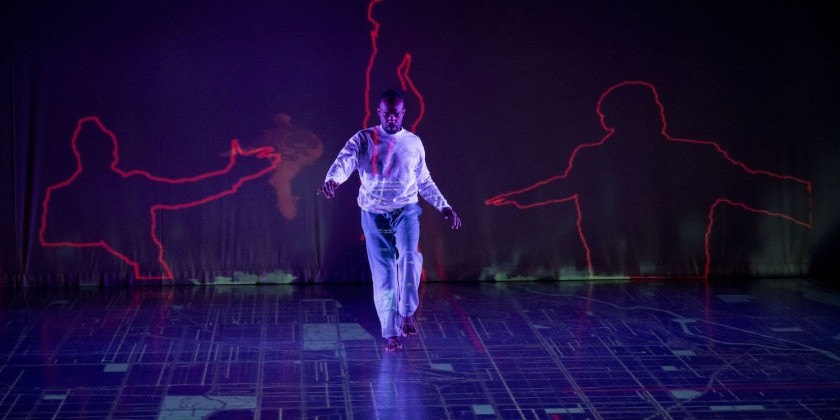IMPRESSIONS: Slowdance and Lucia Gagliardone Present “while I was homegrowing” in Association with The Tank

Choreography: Lucia Gagliardone
Performance: Alex Francois, Lucia Gagliardone, Morgen Littlejohn, Uila Marx
Movement collaboration: Alex Francois, Alexis Vinzons, Julia Sloane, Morgen Littlejohn, Rush Johnston, Uila Marx
Sound Design: Elliot Reza Emadian, Lucia Gagliardone, and Brennan Pope (Vision of a Kiss)*
Lighting Design: Caroline David
Stage Management: Sammie Murray
Photography + Production Assistance: Ty Gagliardone
Videography: Jordan Brookins, Kayla Glazer
Graphic Design: Lou Sydel, original block print by Lucia’s mom Carol Harry
Dramaturgy: Elliot Reza Emadian and Lou Sydel
*Sound design includes original sound by Elliot Reza Emadian, conversations between Lucia and her family, music from Metá Metá, Ian William Craig, London Dance Collective, Roomful of Teeth, The Story, Levon Minassian, Jim Rooney, Jon Batiste, David Bowie, the B 52's (edited by Brennan Pope), and sounds from the Royalton Radio Station and walks through the forest in Sharon, Vermont.
Dates: November 14 - 17, 2024
A New York City black box presents artists with the daunting task of transforming a purposefully neutral, liminal space into a suitable home for their work.
As the house filled, I became acquainted with the stage at The Tank — square, littered with residual spike marks, with brick walls painted black and the work’s signature empty clothesline, which was reproduced in print form on the postcard I was dealt by an usher. A small slip bearing a QR code for the digital program was clothespinned to each hand-made card. For me, QR code programs are the worst vestige of some certain unprecedented times, but Lucia Gagliardone, choreographer and cofounder of slowDANCE, made them her own. Her postcards, complete with stamps, promised the work would touch each viewer with warmth and intention. She and her collaborators delivered.

“while I was homegrowing” unfolded as an homage to Gagliardone’s father’s mother, who she never met. Recordings of conversations between father and daughter revealed that Gagliardone grew up calling her “Angel Peg.” The work leaned into anecdotalism, supported by varied engagements with a large pile of clothes and the omnipresent clothesline upstage. The performers — Alex Francois, Morgen Littlejohn, Uila Marx, and Gagliardone — played dress-up and tug-of-war, hung the clothes, folded them, laid them out, put them on, and took them off. Through this opening task-based score of play, they immediately and succinctly shaped their world. The brick walls painted black were still brick walls painted black, but they no longer appeared to matter; “while I was homegrowing” is such a definitive and sincere realm that it could exist anywhere, undisturbed.
The work did not shy away from specificity in its efforts to conjure a person. Among the assortment of clothing, a cobalt blue dress found its home in two places: downstage right, carefully laid flat, and on Gagliardone’s body. Each time Gagliardone put it on, she became more assured in her senses of wonder and yearning, which she’d expressed more playfully in the beginning of the work. The dress heightened the stakes.

The voice of Gagliardone’s father revealed a memory of a distraught Angel Peg, crying: “Nobody loves me, nobody cares about me.” The four performers arrived downstage and brushed their thighs repeatedly with urgent exhales, until they each erupted into a high release. Slowly, they looked at one another, each with a different expression—fear, desire, tenderness, curiosity. “They insulated us from her emotions,” he adds. “We were teenagers… I never got to be an adult and recognize the value of this woman.”
In a thrashing, impassioned solo by Marx, with Caroline Shaw’s breathy Partita for 8 Singers sung by Roomful of Teeth, even the most idiosyncratic gestures appeared as familiar as a handshake. Pulling, digging, searching, they were desperate for something unidentifiable. When the music shifted—mourning, nostalgic, gorgeous—the other three performers emerged from stage left and observed quietly, recognizing her value, perhaps, or something of the like.
Marx later stepped down off the stage and was bathed in a ghostly, pale light. They approached several audience members in the front row and silently, graciously, bowed with arms extended in offering of something none of us could see.
“What were ways that she showed love?” the voice of Gagliardone asked her father.
“That was her go-to,” he replied.
The clothes, I noted here, had been through so much already.

In a poignant shift from the work’s persistent warmth and glow, a new scene emerged: clothes lying flat on the stage, positioned with heads upstage and feet downstage, illuminated by a dim, bluish hue from a row of shin lights. Gagliardone looked out over the field of bodies implied. She made her way through, tossing some away, laying down across others, until she found her way back to the blue dress. She laid on top of it and stood back up repeatedly and with increasing urgency, causing it to wrinkle more with each return. Finally, she smoothed it back out with great care.

“while I was homegrowing” read to me as a powerful effort by Gagliardone to understand Angel Peg as fully as possible through the process of relating. Colorful clothing, an extremely varied yet traceable soundscore, and evocative memories spoken by Gagliardone’s father contributed to this rich and nuanced process, but it was the performers’ palpable care, respect, and admiration for one another that anchored the work in earnest compassion. Phrases emerged seamlessly from moments when the dancers were disparately occupied, not interrupting the storytelling but rather uplifting it. The persistent clarity among the performers meant that even the most virtuosic dancing held its intrinsic meaning.
Gagliardone and company are well on their way to becoming a vital voice in the New York contemporary dance scene.















